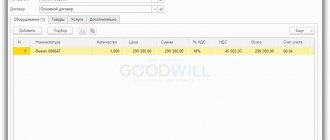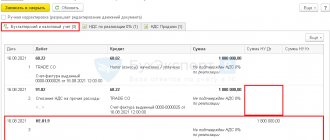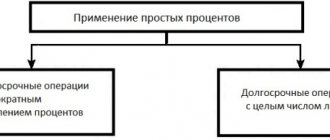Concept and types of trade
Trade is a separate branch of the economy associated with the process of transferring inventory, initially purchased for subsequent resale, for a fee from the seller to the buyer and includes a set of specific operations performed in this case.
There are 2 types of trade: wholesale and retail.
Wholesale trade is the transfer of goods and materials for a fee from the manufacturer (seller) to another seller for subsequent retail sale. Carried out in large quantities, usually at a lower price than retail.
Retail trade - single (piece) transfer of goods and materials for a fee to the end consumer.
Accounting in trade, retail and wholesale, differs both in its legislative approach and in the algorithm for reflecting business transactions. Let's look at these differences in more detail.
Wholesale and retail
Trade, and therefore accounting in it, traditionally has two directions:
- wholesale;
- retail.
The difference between them lies in the volume of products sold. Retail sales involve small batches or single products, most often intended for the personal needs of the population. Wholesale trade operates in large quantities. Of course, there is a difference in accounting. Indeed, in retail, the parties to the transaction, as a rule, are an organization-seller and an individual buyer, and in wholesale trade, products are bought by other legal entities or individual entrepreneurs. In the first case, cash payments are used, and in the second, non-cash payments. All this must be taken into account when maintaining accounting records.
Accounting in wholesale trade: postings
Here are the basic accounting records in trade organizations. We will show transactions in trade when conducting wholesale sales.
| Operation | Account debit | Account credit |
| Products purchased | 41 | 60 “Settlements with suppliers and contractors” |
| VAT on purchased goods is reflected | 19 “VAT on purchased assets” | 60 |
| Reflects intermediary services for the purchase of goods, delivery costs, customs duties | 41 | 60, 76 “Settlements with various debtors and creditors” |
| Revenue from the sale of goods is reflected | 62 “Settlements with buyers and customers” | 90 “Sales”, sub-account “Revenue” |
| VAT charged on goods sold | 90, subaccount “VAT” | 68 “Calculations for taxes and fees” |
| Cost of goods sold written off | 90, subaccount “Cost of sales” | 41 |
| Costs associated with the sale of goods are reflected | 44 “Sales expenses” | 60, 10 “Materials”, 70 “Settlements with personnel for wages”, 69 “Calculations for social insurance and security”, etc. |
| Expenses associated with the sale of goods are written off | 90, subaccount “Sales expenses” | 44 |
| Payment received from customers for goods sold | 51 “Currency accounts”, 52 “Currency accounts”, etc. | 62 |
| Profit from the sale of goods at the end of the month was revealed | 90, subaccount “Profit/loss from sales” | 99 "Profits and losses" |
When writing off a defect in trade, the postings will be the following, if the defect is discovered after the goods have been posted and it is not the supplier’s fault:
| Operation | Account debit | Account credit |
| Defective goods in warehouse detected | 94 “Shortages and losses from damage to valuables” | 41 |
| The loss of goods was written off within the limits of natural loss | 44 | 94 |
| Losses in excess of natural loss norms are written off (in the absence of culprits) | 91 “Other income and expenses”, subaccount “Other expenses” | 94 |
| Losses from defective goods are attributed to the perpetrators | 73 “Settlements with personnel for other operations” | 94 |
Accounting in retail trade
Retail accounting is a little more complicated than wholesale, because by virtue of Order of the Ministry of Finance dated October 31, 2000 No. 94n, it is necessary to use account 42 “Trade margin” in your work. This is due to the fact that if goods are recorded at sales prices, it is necessary to highlight the markup, as well as possible discounts. The markup is formed by postings that look like this:
Dt 41 Kt 42.
On account 42, it is imperative to organize analytical accounting in order to be able to distinguish between markups on goods in retail organizations and on goods already sold to customers. The shipped margin is usually reversed as follows:
Dt 90, subaccount “Cost of sales” Kt 42.
In addition, in retail it is necessary to take into account selling costs. The corresponding accounting entries are as follows:
- Dt 44 Kt 60, 10, 70, 69, etc. - costs associated with sales;
- Dt 90, subaccount “Sales expenses” Kt 44 - write-off of expenses associated with sales.
At the end of the month, the accountant must display the profit based on the sales results and reflect it in the following way:
Dt 90, subaccount “Profit/loss from sales” Kt 99.
Accounting entries in retail trade with UTII differ from those given above only in the absence of VAT, and therefore the need to allocate it. The use of count 42 is mandatory.
Accounting in wholesale trade
Wholesale trade involves selling large quantities of goods at a low cost. Typically, products are sold to retail companies. As part of accounting, ongoing transactions must be reflected: receipt of inventory, their sale, movement within the company.
Question: Can a supplier (manufacturer) who buys back expired goods not sold by the buyer take into account for income tax purposes the costs of repurchasing such products (clause 1, article 252, clause 49, clause 1, article 264, clause 20 clause 1 article 265 of the Tax Code of the Russian Federation)? View answer
Receipt of goods and materials
Postings are used to record the receipt of goods. The receipt of valuables is reflected using these entries:
- DT41 KT60. Admission.
- DT19 KT60. Reflection of incoming VAT.
Question: Does the seller (supplier) have the right to take into account for income tax purposes the costs of priority display of goods, the ownership of which has transferred to the buyer (retailer)? If expenses can be taken into account, then in what order (clauses 28, 49, clause 1 and clause 4 of Article 264 of the Tax Code of the Russian Federation)? View answer
Postings must be confirmed by an invoice in the TORG-12 form, or an invoice. PBU 5/01 states that direct expenses for the purchase of valuables are included in the cost price. Direct expenses include these expenses:
- Delivery of valuables.
- Duty paid at customs.
- Payment for the services of intermediaries and consultants.
- Income that is not reimbursed.
- Insurance.
How to account for goods in wholesale and retail trade ?
Direct expenses must be recorded using this posting: DT41 KT60.
ATTENTION! If the company maintains simplified accounting, direct expenses can be taken into account as part of expenses for the main areas of activity. This is only possible if there are no significant balances in the warehouse.
Movement of valuables within a retail facility
Once the values are accepted, they can be moved to other departments. Expenses for internal movement and storage of inventory items are recorded in the cost structure for the main areas of activity. Let's look at the wiring used:
- DT44 KT60. Cost of third party services.
- DT19 KT60. Reflection of incoming VAT.
Postings must be confirmed by contracts with third-party companies, notes on the movement of valuables.
Realization of values
When selling consignments of goods, these postings are used:
- DT62 KT90/1. Sale of valuables.
- DT90/3 KT68. Allocation of VAT on sales.
- DT90/2 KT41. Write-off of sold assets at their actual cost.
Transactions are confirmed by checks and contracts with customers.
Accounting for inventory items
Goods purchased by the company for the purpose of resale are subject to accounting in 41 accounts “Goods”. As a rule, several sub-accounts are opened for this account, which any organization can determine independently. Accounting for inventory items is carried out according to the following criteria:
- name (nomenclature);
- quantity;
- storage;
- financially responsible persons.
The cost price is understood as the purchase price of goods and materials in the amount of delivery costs, duties, agency fees and other expenses.
Features of accounting in wholesale trade
Accounting in wholesale trade includes recording the facts of receipt, internal movement of goods and materials and final sale to the buyer for subsequent resale.
Receipt of goods and materials
Receipt of inventory items is recorded by the following records:
- Dt 41 Kt 60 - receipt of goods and materials;
- Dt 19 Kt 60 - input VAT is allocated.
It is accompanied by a delivery note in the TORG-12 form and an invoice.
According to clause 11 of FSBU 5/2019, all direct costs associated with the purchase of inventory items must be included in their cost. Direct costs include:
- actually, the price paid to the seller;
- procurement and delivery;
- bringing stocks to a condition in which they are suitable for use;
- estimated liability for dismantling, disposal of stockpiles and environmental restoration;
- interest associated with the acquisition (creation) of inventories, which are subject to inclusion in the cost of the investment asset;
- others related to the acquisition (creation) of inventories.
Such expenses are reflected by posting: Dt 41 Kt 60.
IMPORTANT! Micro-enterprises that have the right to use simplified accounting methods, expenses that, in accordance with FAS 5/2019, should have been included in the cost of inventories, can be recognized as an expense of the period in which they were incurred (clause 2 of FAS 5/2019). A similar norm existed before 01/01/2021 in paragraphs. 13.1–13.3 PBU 5/01.
Read about which companies have the right to use simplified accounting methods here.
Internal movement of goods and materials and other costs associated with preparation for sale
After receiving the goods at the warehouse, they can be moved to other divisions of the company. In this case, the costs of delivery between departments, storage and other similar costs are taken into account as part of expenses for ordinary activities. There may also be other costs associated with the sale (packaging, advertising).
These operations carried out with the involvement of third parties are reflected in accounting transactions:
- Dt 44 Kt 60 - services of third-party organizations (IP) are reflected;
- Dt 19 Kt 60 - input VAT is allocated.
These operations can also be carried out in-house. Then this will be expressed by postings:
Dt 44 Kt 70 (69, 10, 02, 76).
The last of the above entries also accrues general expenses associated with the maintenance of the management apparatus, retail and warehouse space, and own transport.
Sales of goods and materials
The sale of wholesale goods is usually carried out in large quantities to a specific buyer.
Wiring block:
- Dt 62 Kt 90.1 - sale of goods and materials to the buyer;
- Dt 90.3 Kt 68 - allocated VAT on sales;
- Dt 90.2 Kt 41 - write-off of sold inventory items at actual cost;
- Dt 90.2 Kt 44 - write-off of sales expenses.
Receipt of payment (and prepayment) for goods sold in bulk is usually carried out by non-cash means, which is reflected by the posting:
Dt 51 (52) Kt 62.
There are several cases when implementation needs to be taken into account using account 45. ConsultantPlus experts spoke about them. Get trial access to the system for free and go to the Ready-made solution.
Features of tax accounting in trade organizations
"Financial newspaper EXPO" No. 3
“Do those who don’t count anything know how to count money?” V. Vlasova
Chapter 25 of the Tax Code of the Russian Federation (TC RF) establishes principles common to all taxpayers for recognizing income and expenses, maintaining tax records, and the procedure for reflecting income and expenses (cash method or accrual method). However, in accordance with Art. 252 of the Tax Code of the Russian Federation for certain categories of payers may provide for some features of cost accounting. Organizations engaged in wholesale, small wholesale and retail trade determine the expenses of the current period, taking into account the individual provisions of Chapter 25 intended for this group of taxpayers.
Tax accounting recognizes only those expenses that are economically feasible, related to activities aimed at generating income, and supported by documents (Article 252 of the Tax Code of the Russian Federation). Moreover, the documents must be drawn up in accordance with Russian legislation.
If an expense can simultaneously be attributed to several groups, the taxpayer has the right to independently determine which group he will assign them to. An expense can be taken into account in tax accounting only once.
When determining expenses using the accrual method, they are recognized in the reporting period in which they were incurred. When determining expenses using the cash method in tax accounting, they are recognized after they are paid.
Distribution costs do not include the purchase price of the goods. The term “purchase value of goods” is used in the Tax Code of the Russian Federation to indicate the cost of goods according to the terms of the purchase and sale agreement. The purchase price of goods is taken into account as expenses when they are sold in accordance with paragraphs. 3 p. 1 art. 268 Tax Code of the Russian Federation.
When selling purchased goods, income from sales can be reduced by the cost of purchasing these goods (purchase value). The cost of goods is determined by one of four methods approved in the accounting policy for tax purposes:
- at the cost of the first in time of acquisition (FIFO);
- at the cost of the most recent acquisition (LIFO);
- at average cost;
- at the cost of a unit of goods.
Example.
Rassvet LLC is engaged in wholesale trade. In January 2003, the organization purchased goods, the cost of which, according to the supply agreement, was 6,000,000 rubles. (including VAT – 1,000,000 rubles). The goods were sold in the same month. The cost of goods in tax accounting is determined by the cost of a unit of goods. As part of the costs associated with production and sales, in January you need to take into account 5,000,000 rubles. (6,000,000 – 1,000,000).
It must be taken into account that the sale of a product for tax purposes is a transfer of ownership of it. Therefore, the purchase price of goods shipped but not sold in the current period is not taken into account as expenses in tax accounting. It must be taken into account as part of the costs associated with production and sales in the reporting (tax) period when, in accordance with the contract, the transfer of ownership of such goods occurs.
Distribution costs, which are accepted for profit tax purposes, are calculated in several stages.
First of all, expenses must be attributed to one or another type of activity. If, in accordance with the documents, it is impossible to accurately organize separate accounting of expenses, the organization must choose a method for allocating costs by type of activity. It is most rational for trade organizations to divide expenses in proportion to the share of revenue from each type of activity in total revenue. The chosen method must be recorded in the accounting policy order.
At the second stage, expenses that relate to taxable profit must be divided into expenses that relate to production and sales, and non-operating expenses (clause 2 of Article 252 of the Tax Code of the Russian Federation).
Accounting at the third stage depends on the chosen accounting policy for tax purposes: accrual or cash basis.
If the taxpayer accounts for income and expenses using the cash method, filtering costs ends at the second stage. For tax purposes, all recognized expenses are accepted.
If the accounting policy establishes the procedure for determining income and expenses based on accrual, then at the third stage, expenses associated with production and sales must be divided into direct and indirect (clause 2 of Article 252 of the Tax Code of the Russian Federation). The general principle of assigning expenses to one or another group according to this classification is set out in Art. 318 Tax Code of the Russian Federation. However, the Tax Code provides for some special features for trade organizations (Article 320 of the Tax Code of the Russian Federation).
According to the Tax Code of the Russian Federation, direct expenses in trade organizations include the purchase price of the goods and the costs of its delivery, if such costs are not included in the purchase price of the goods (the procedure for accounting for the purchase price of goods, which is regulated by clause 3 of Article 268 of the Tax Code of the Russian Federation, is discussed above). The remaining expenses are indirect and can be written off in full as expenses of the reporting (tax) period.
Direct expenses can only partially reduce taxable profit for this period. The part of direct expenses that relates to goods in the warehouse will not reduce income from sales in tax accounting. The specified part of direct costs is determined in the following order.
First, the average percentage is determined:
Average percentage = (Direct expenses at the beginning of the month + direct expenses for the current month (according to tax accounting data)): (Cost of the balance of goods at the beginning of the month + cost of goods sold in the current month (according to tax accounting data))
Then you can determine the amount of direct expenses that will not reduce the tax base of the current period (it is equal to direct expenses that relate to the balance of goods):
Direct expenses that relate to the balance of goods = Average percentage x Cost of the balance of goods at the end of the period (according to tax accounting data)
Example.
At the beginning of January, Opttorg CJSC had no goods in its warehouse. On January 3, the organization purchased goods, the cost of which, in accordance with the supply agreement, is 1,020,000 rubles. On the same day, Opttorg transferred 10,000 rubles. for delivery of goods. Some of the goods were sold on January 23, their purchase price was 1,000,000 rubles. At the end of January, there were goods left in the warehouse, their purchase price was 20,000 rubles. Salary expenses (together with insurance contributions) in January amounted to 300,000 rubles. The cost of renting office and warehouse premises amounted to RUB 120,000. In tax accounting for January, depreciation in the amount of 10,000 rubles was accrued for depreciable property.
We will divide the costs associated with the acquisition and sale of purchased goods into direct and indirect. Direct costs include only delivery costs (the purchase price of the goods is considered direct costs, but is taken into account in a special manner), i.e. direct expenses for January are 10,000 rubles. All other costs are considered indirect. Their value was: 430,000 rubles. (300,000 + 120,000 +10,000).
Let's determine the amount of direct costs that relate to the balance of goods in the warehouse:
1. Average percentage = 10,000: 1,020,000 = 0.01 (i.e. 1%) + UTII.
2. Direct costs that relate to the balance of goods =
0.01 x 20,000 = 200 rub.
3. Direct expenses of the current period = (10,000 – 200) + 1,000,000 (purchase cost of goods sold) = 1,009,800 rubles.
Thus, in January, taxable income can be reduced by RUB 1,009,800.
To summarize what has been said, we note that in fact, in the tax accounting of a trading enterprise, only transportation costs are subject to distribution between the balance of goods in the warehouse and the goods sold, if such costs do not relate to the purchase price of the goods. If, according to the terms of the contract, the cost of delivery of goods is included in the contract price of the goods, direct costs do not require distribution, and the purchase price of the goods reduces the income from sales in the manner established in the order on accounting policy for tax purposes.
Features of accounting in trade
Accounting in trade is about correctly executed documents and transactions drawn up on their basis.
Goods for resale are accounted for in account 41. The account has several subaccounts. The most commonly used account is 41.4 “Purchased Items”.
Goods are accounted for by name, quantity, storage location and financially responsible persons.
The cost of a product is its acquisition price, delivery costs, duties, agency fees, etc. (clause 6 of PBU 5/01).
for finished products. This account cannot be used in trading. Here you will need account 41 “Goods”. Sub-accounts are opened for this account. The purchase of goods is reflected by posting Debit 41 Credit 60. If necessary, VAT is allocated as a separate posting.
The sale of goods includes three entries: Debit 62 Credit 90 - revenue Debit 90 Credit 68 - VAT Debit 90 Credit 41 - cost
Let's analyze the differences between accounting in trade for wholesale and retail sales.
Commission trading
It happens that an organization does not sell its own goods, but goods and materials received for sale under a commission agreement. In this case, accounting in trade has a number of features that are imposed by commission trading. The commission agent's transactions will be completely different. For clarity, we have displayed the most basic accounting entries in the table:
| Operation | Account debit | Account credit |
| Admission to the commission | 004 “Goods on consignment” | |
| Commission sales | 50, 57, 62 | 76, subaccount “Settlements with the principal” |
| Write-off of realized commission values | 004 | |
| Expenses associated with commission sales that are not reimbursed by the consignor | 44 | 60, 10, 70, 69, etc. |
| Expenses associated with commission sales reimbursed by the principal | 76, subaccount “Settlements with the principal” | |
| Commission remuneration | 76, subaccount “Settlements with the principal” | 90, subaccount “Revenue” |
| VAT on revenue under a commission agreement | 90, subaccount “VAT” | 68 |
| Write-off of expenses associated with commission sales | 90, subaccount “Sales expenses” | 44 |
| Profit from the sale of goods at the end of the month | 90, subaccount “Profit/loss from sales” | 99 |
| Transfer of funds to the principal (minus the commission agent's remuneration and reimbursable expenses) | 76 | 51 |
Please note that the primary document for capitalization in accounting is the delivery note (form No. TORG-12). And account 004, which is used to capitalize inventory items on commission, is off-balance sheet. Accounting is carried out at the prices specified in the acceptance certificate by the committing organization.
Legal documents
- Order of the Ministry of Finance of Russia dated 06/09/2001 N 44n
- Order of the Ministry of Finance of the Russian Federation dated October 31, 2000 N 94n
Receipt of goods
When goods arrive at a wholesale trade company, they are accounted for, which involves the following transactions:
| Business transaction | D | TO |
| Receipt of goods and materials | 41 | 60 |
| VAT accounting | 19 | 60 |
| Payment for goods to the supplier | 60 | 51 |
If goods and materials are received, their cost should include costs associated with the transportation of goods, insurance, customs duties, payment for intermediary services, payment for consulting services, etc. The posting for such costs is as follows: D41 K60.




